617 Search Results for tell me about it
December 26, 2013
by Carole Zangari -
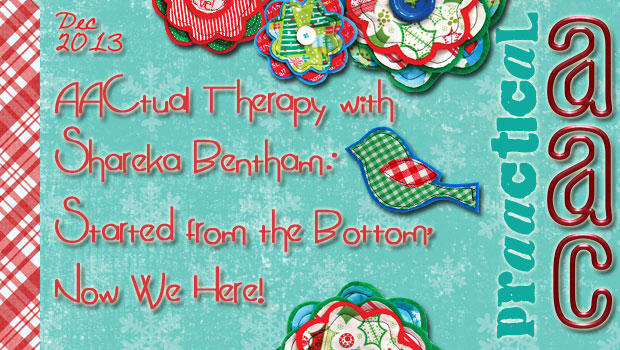
We’re so thrilled to have Shareka Bentham back as an AACtual Therapist, this time talking about her journey into high tech AAC. You can see other posts from Shareka here. One of our colleagues completed the AAC evaluation on a client of Shareka’s. While preparations for that evaluation were underway, we were fortunate enough to learn of an AAC device that was no longer needed. The family agreed to donate it to this little fellow, and that seems to have launched a whole chain of prAACtical events. Shareka takes it from here… Sadly, this is not the first step into my career as a rapping superstar, but more a description of my journey from ‘no tech’ to high tech in AAC use. If someone had told me a year ago that I would be showing off my skills on a high tech AAC device, and teaching children, parents, and teachers... [Read More...]
December 24, 2013
by Robin Parker -

Use social narratives to explain happy upcoming events, stressful upcoming events, and out of the routine type events. Not only do social narratives help with understanding, but they can also help with ways to talk about activities and events. Use Aided Language Input (ALI) to model. It will show that even when there is a lot going on, AAC is still important and a high priority. Give out some AAC related presents to educators, professionals, families, and AAC users. Create the visual supports for holiday songs and poems. Or use a single step or sequential message device to record the songs, so everyone can sing together. You can even program the songs into high tech devices and have quite the good singing voice. Provide frequent communication opportunities for the AAC user to make choices, give opinions, rate activities and events, vent, ask questions, tell, and share information. Make talking photo... [Read More...]
December 19, 2013
by Robin Parker -
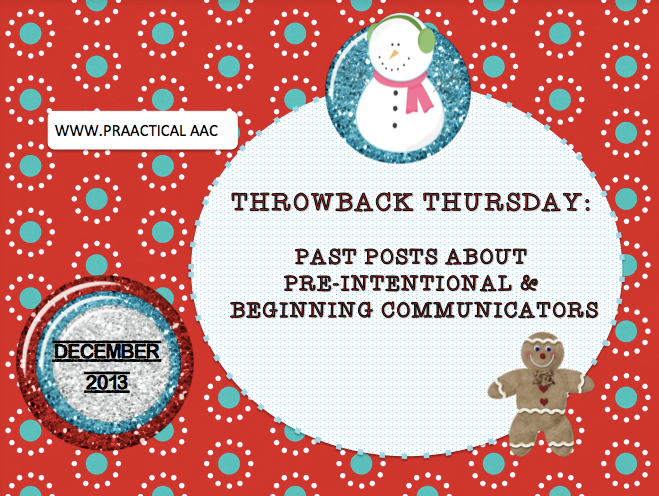
The Strategy of the Month for December is about Pre-Intentional and Beginning Communication. We knew this topic meant a lot to us because these learners are often overlooked or given up on just when they need help the most. We didn’t realize how important it was to us, until we started ’rounding up’ our past posts and found so many. We are fortunate to have worked with many pre-intentional and beginning communicators because they often teach us the most, and we love learning. Presuming Competence 3 Responses to Programs that Make Kids “Prove Worthiness” Prior to Providing Access to AAC Does AAC Benefit Individuals with Profound & Multiple Disabilities Strategy of the Month Strategy of the Month: Supporting Pre-Intentional Communicators Breaking Through with Pre-Intentional & Beginning Communicators of All Ages Supporting Pre-Intentional Communicators Teaching Basic Requests Making it Work: The PrAACtical Side of Therapy to Teach Requests Literacy Lessons for... [Read More...]
December 10, 2013
by Carole Zangari -
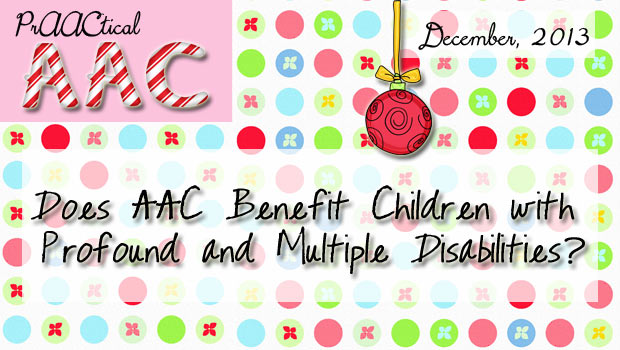
For most SLPs, it is easy to see how AAC can be beneficial to someone with motor difficulties, like cerebral palsy or ALS. To say that AAC strategies and technologies can be life-changing for these individuals is not an understatement. Similarly, the fields of SLP and special education now recognize that visual supports and AAC options are a standard of care for people affected by autism who have little or no functional speech. Not only does AAC provide a means for functional communication, but it also plays facilitative important role in speech and language development. To be sure, there are significant challenges in the implementation of AAC supports and services with these populations, but the practices themselves are now widely recognized for their positive impact on communication, literacy skills, independence, and behavior. But what about individuals with the most significant learning challenges? In this post, we share an article looking... [Read More...]
December 7, 2013
by Carole Zangari -
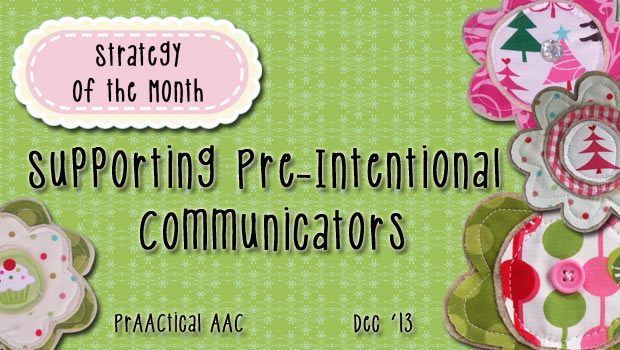
Scene 1 Alex looks at the picture symbol choices placed in front of him and knocks them to the floor. Simone looks distressed while she waits for her lunch and whines as she watches her classmates eating. Jason smiles engagingly and rocks enthusiastically when his favorite aide enters the room. Kyra takes a picture from her PECS book and begins to chew on it. Scene 2 “He can’t even make choices. I’m not even sure what he wants.” “She really doesn’t communicate.” “He doesn’t mean anything by it. He does that all the time.” “She needs hand-over-hand prompting for everything.” Great kids, caring professionals. Ineffective communication. This month, we focus on ways to support children and adults at the earliest stages of communication. It isn’t easy trying to figure out how to provide effective SLP services to individuals who are not yet sending messages intentionally. Communicators at the pre-intentional level are... [Read More...]
December 4, 2013
by Carole Zangari -
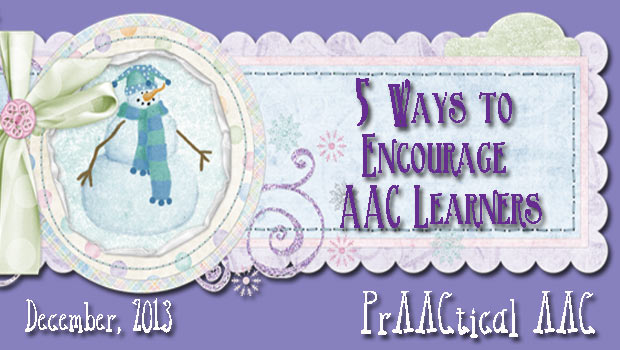
As clinical educators, we have lots of conversations with student SLPs about reinforcement of specific skills. We’ll save that for another post, but today we want to put reinforcement into a large context. We all learn best in an environment in which we are accepted and encouraged. It’s often hard to ‘see’ how to do that in a therapy session where the AAC learner has so many skill deficits, particularly if you are starting out in your AAC career. Here are some ideas. Accept their responses without judgment.The Dot (click on image) is a great reminder to us all of how our responses to a learner’s attempt can make ALL the difference in how they see themselves. Use the language of communication. Instead of ‘show me on your board’ or ‘point to what you want,’ use communication-oriented verbs, like ‘tell’ or ‘say.’ “Tell me what you’re thinking.” “I like what... [Read More...]
November 29, 2013
by Robin Parker -
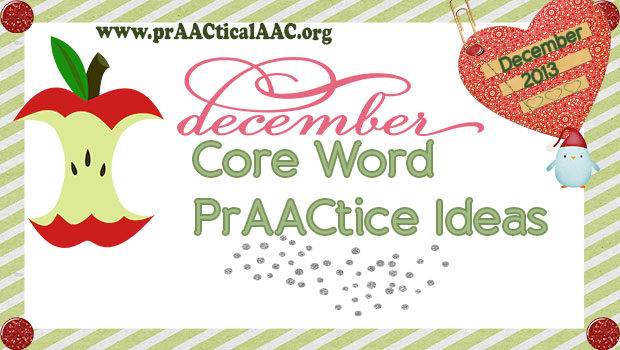
December core word prAACtice ideas are here. The best way to TEACH core words is to first provide Aided Language Input- ALI in Meaningful Language Experiences. Then give the learner a chance to be an active participant by having many (many, many) opportunities to USE the core words to request, question, complain, tell, negotiate, explain, refuse, tattle, greet, ask, vent, and discuss. There is a lot of holiday spirit this month. Here are some ideas of activities that can go with the core word words, phrases and sentences: Play Holiday Music– All holidays can be represented. Model “hear it louder”, “surprise us” for the next song, or even wear “silly hats” while singing. Cook & Eat Fun Holiday Food– As you are creating/cooking holiday treats, everyone can take a turn saying “mix it this way” or “add it this way“. Have each learner say “these next” or “please one more” or even “I want... [Read More...]
November 25, 2013
by Carole Zangari -

As any experienced AAC professional will tell you, people who are learning to use AAC systems don’t produce as much verbal output as their speaking peers. And, every once in awhile, we run into an AAC learner who communicates VERY infrequently even though they are capable of doing more. They’re often described as shy (perhaps) or stubborn (cringe! shudder! clench teeth!), but, in our view, their reluctance to communicate is probably related to a few other things. We generally don’t like to do things that are difficult for us, particularly if the pay-off is not in proportion to the effort, or if there are insufficient supports. If the learner has had a history of being unsuccessful or associates communication with a high level of effort, it makes sense that they are not rushing to interact with us. It doesn’t always pay to rush things. Sometimes we get better outcomes by building... [Read More...]
November 15, 2013
by Carole Zangari -
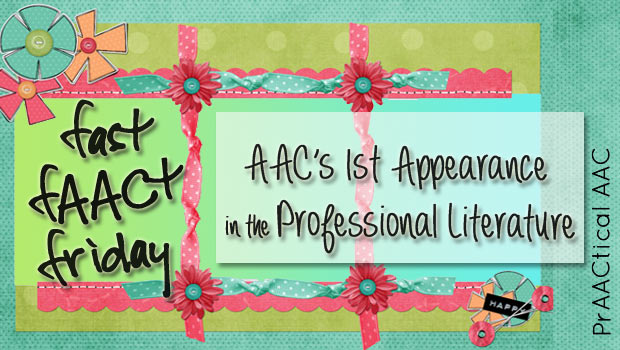
Today’s Fast FAACt deals with the origins of AAC in clinical practice. Many people assume that AAC is a new field. While it certainly doesn’t have as long a history of as articulation or fluency disorders, neither did it just pop up in the last decade. Or the the previous one, or the one before that. When did AAC first appear in the professional literature? If you guessed the 80’s,you’re off by a bit. the 1970’s? Not quite. As far as we can tell the first published article on augmentative communication strategies was in the early 1950’s. The topic? Augmenting communication for people with aphasia. Here’s the reference: Goldstein, H., & Cameron, H. (1952) New method of communication for the aphasic patient. Arizona Medicine, 8, 17-21.
November 11, 2013
by Robin Parker -
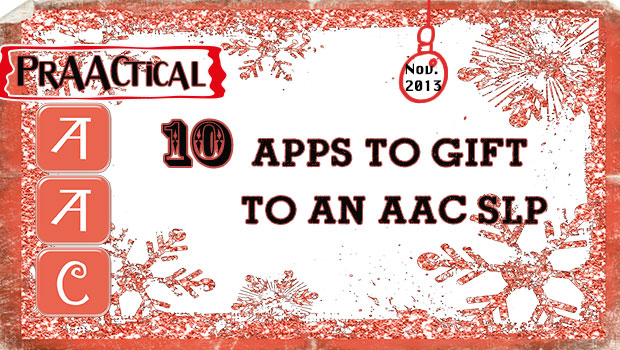
It’s definitely time to think about the holidays because they are almost here. Apps are often a great gift for your colleagues or for the SLP working with your child. Here are just a few suggestions that will help the SLP. Please feel free to share others you think should be added to this list. Evaluation Genie – This app is an informal assessment tool that helps with identifying skill areas that relate specifically to the language representation methods commonly found on augmentative communication systems. There are 14 subtests that help with identifying the features for an AAC device that a student would need. The student responses are recorded and easily reportable. ATEval2Go – designed helps guide you through a template for technology considerations so that the SLP can document observations and information in a structured manner. All the documentation can then generate an editable usable report. Additionally, a goal bank can be... [Read More...]









